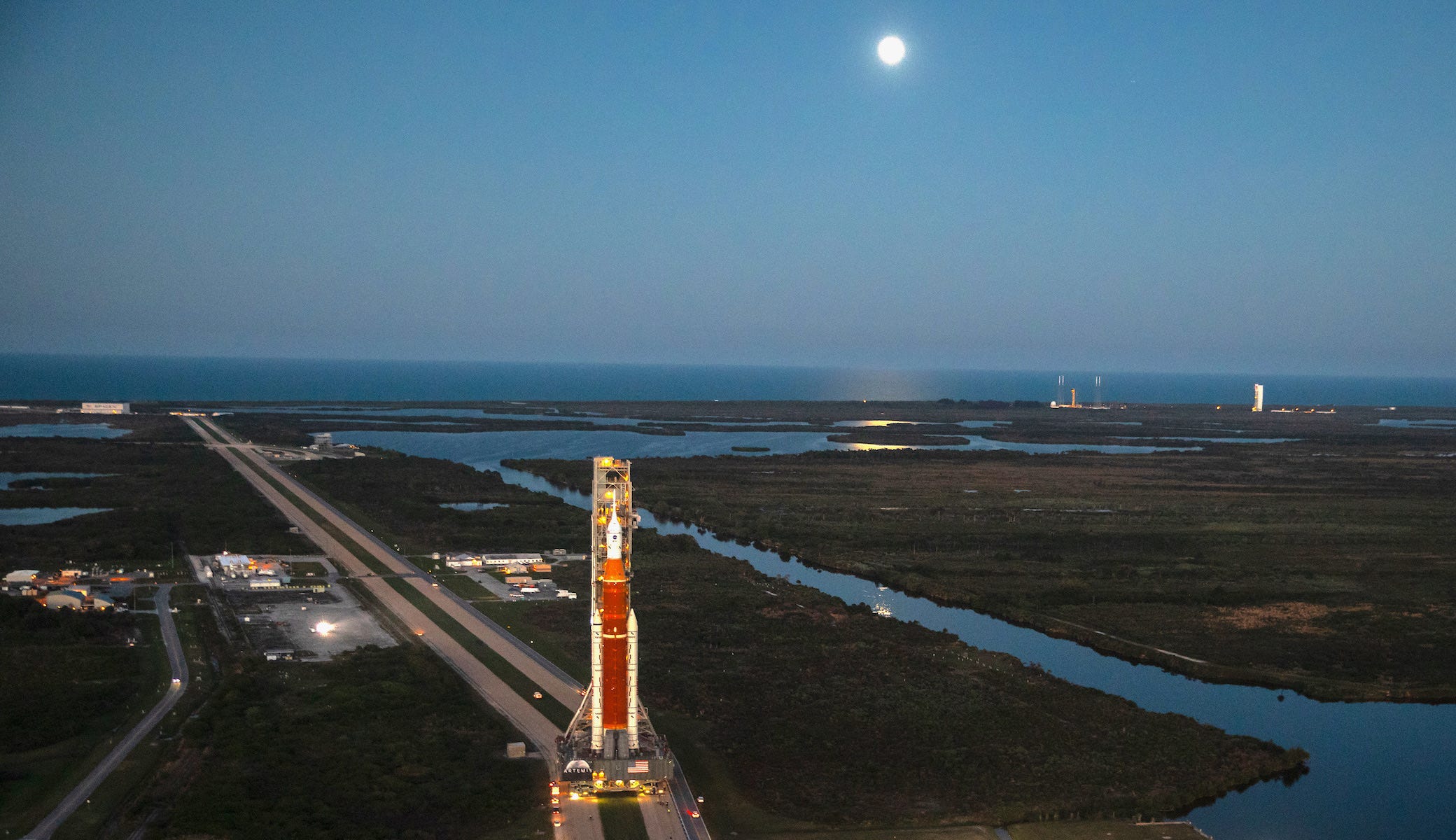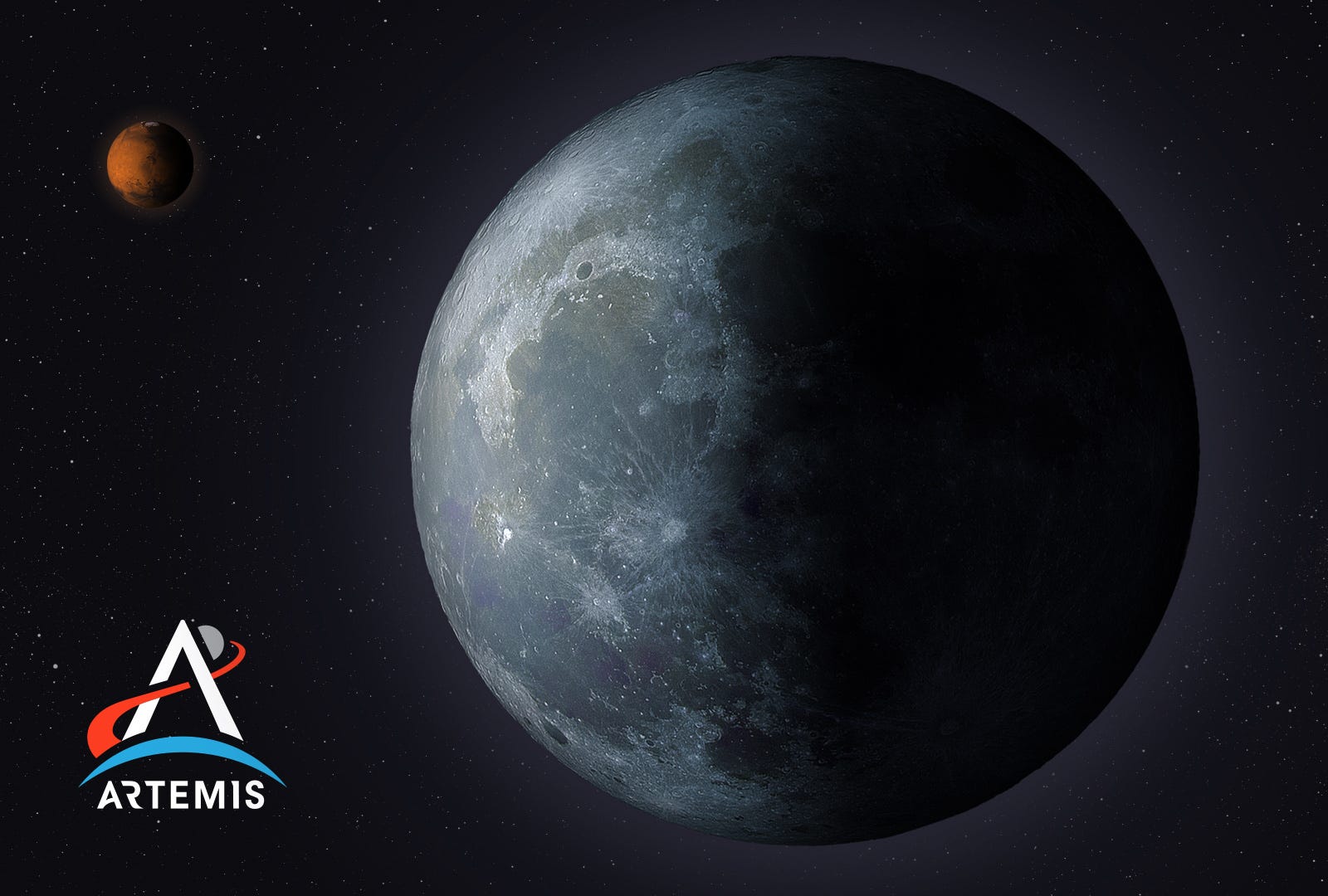Moon Monday #96: Another storm for SLS, a lunar power service, a refined Lunar-Mars vision, and more updates
NASA wants the SLS rocket and its teams to withstand a storm
On September 21, NASA successfully conducted the cryogenic leak test to verify the integrity of the newly replaced seals on the SLS rocket’s core stage, where a persistent, large hydrogen leak forced the agency to scrub the September 3 launch attempt of the Artemis I mission to send an uncrewed Orion spacecraft around the Moon and back. Notably, hydrogen leaks still cropped up during the test, including at the exact same spot, but engineers sufficiently controlled them by more “gently” loading the super-chilled propellents.
Soon after the test, the Eastern Range approved NASA’s request to extend the battery rating of SLS’ flight termination system to allow a launch attempt on September 27 but a tropical storm nearing Florida forced agency officials to let go of that possibility. And yet NASA officials want the rocket and its teams to weather the storm, instead of rolling the rocket back to its assembly building, just so they can hope for an October 2 launch. Eric Berger has an excellent report on just how much NASA officials downplayed the storm last week. Essentially, it’s because the rocket is fully stacked since almost a year now—meaning critical parts would soon need servicing—that NASA is in a hurry to blast the big orange rocket away from Earth.
Update: NASA decided to roll back SLS to its assembly building after all. Phew.

Astrobotic reveals plans for first ever power grid on the Moon
On September 19, Astrobotic announced LunaGrid, the world’s first commercial power generation and distribution service to enable hardware on the Moon’s poles to survive on poorly lit terrain and through the frigid nights. Quite cleverly, LunaGrid combines virtually everything Astrobotic has been tangibly building so far—landers, rovers, wireless chargers and, of course, their nearly 10-meter tall, retractable polar solar arrays being funded by NASA at $6.2 million.
Beginning in 2026 at the earliest, Astrobotic’s large Griffin landers will deploy vertical solar arrays on maximally sunlit sites at the Moon’s south pole. Each array itself can wirelessly distribute power to hardware assets approaching it, or tethered autonomy-capable CubeRovers can charge further away assets, also wirelessly as recently ground-tested and supported by a $5.8 million NASA Tipping Point contract. As an aside, Astrobotic itself intends its MoonRanger CubeRover to demonstrate lunar night survival using their wireless charging system, also with NASA funding, on an as-yet-unannounced CLPS mission no earlier than 2025.

Astrobotic says each solar array will include transformers and power management systems to extend capabilities beyond the array itself and thus make the LunaGrid. If Astrobotic really pulls off building a lunar power grid at even the baseline 10 kilowatts target, and crucially somehow pay for its launches, we could see numerous micro-rovers, say, by international space agencies and companies wirelessly charge themselves and live to explore another lunar day.
I think there’s better potential for surface science payloads deployed in proximity to LunaGrid getting the power needed for sustained and enhanced science operations. Lunar night surviving seismometers such as the ones flying on the NASA-funded 2025 farside CLPS mission come to mind, which themselves could enable low-cost pathways to building the Lunar Geophysical Network that scientists highly recommended in the latest Decadal survey.
Many thanks to Epsilon3 for sponsoring this week’s Moon Monday.
NASA updates Moon to Mars objectives based on community feedback
Last week NASA updated the draft set of 50 one-liner, high-level Moon to Mars objectives that the agency released in May, with their aim being to act as guideposts for establishing a permanent human presence on the Moon followed by Mars. These changes came due to community feedback. Below is a broad list of changes NASA made in the revised objectives document.
- Added Recurring Tenets to address common themes across objectives. These broadly include enhanced international and industry collaboration, interoperable and reusable systems, responsible space activities, and leveraging low-Earth orbit infrastructure for lunar activities.
- Elaborated Lunar Infrastructure objectives, and added an Operations objective of minimizing disturbance to the local lunar and martian environment.
- Exploration Science has been renamed, divided into, and expanded as Science-Enabling and Applied Science goals. An interesting addition in the latter is to “Conduct applied scientific investigations essential for the development of bioregenerative-based, ecological life support systems.”
- Curiously, the original fourth Lunar Goal to “Collect samples over a long traverse/duration in the South Pole Aitken Basin and deliver the samples to astronauts for return to Earth” was removed in favor of a totally different one pertaining to advancing our understanding of the origin of life in the Solar System by identifying the nature and evolution of habitable environments.
- Added a Heliophysics Goal: “Determine the history of the Sun and solar system as recorded in the lunar and Martian regolith.”
- Added two Biological Sciences Goals pertaining to crew health and performance on long-term “Mars-class” missions.
- Added as a Physics Goal the acknowledgement of doing more fundamental physics from the Moon than only farside radio astronomy.
Most notably, NASA says it will revisit and refine these objectives each year. However, again, NASA doesn’t mention alongside or anywhere the programs and projects it has already undertaken, and is planning, to specifically meet many of these objectives. Since most changes comprise add-ons or better wording, my previous mapping of the objectives to ongoing NASA efforts might be useful to look at again.

NASA makes milestone payment to ispace Europe for upcoming lunar regolith ownership transfer
In 2020, NASA took another step in incentivizing the industry to build sample extraction technologies by selecting four companies to collect lunar material (collect, not return to Earth) and transfer its ownership to the agency. This move by NASA is to set precedence for resource use under the U.S.-led Artemis Accords. ispace inc. Japan and its subsidiary ispace Europe were two of the selectees. Now post-review, NASA has paid the interim milestone amount to ispace Europe whose micro-rover on ispace Japan’s second Moon mission in 2024 will collect said lunar regolith. ispace Japan itself is yet to receive its milestone payment for what seems to be a proposal to collect regolith using the lander on its first Moon mission launching this November.
Relatedly, with growing interest from space nations around the world to acquire and use lunar resources, and increasingly varied interpretations of what is and isn’t allowed by the 1967 Outer Space Treaty, the Open Lunar Foundation (a Moon Monday sponsor) led the creation of a lunar resources trust to demonstrate better management of resources for all. Orbit Fab intends to purchase a small amount of lunar regolith from another company, presumably from one the four NASA selectees, and transfer it to the trust to set precedence for sustainable lunar resource management.
Also related: Representatives from the 21 countries that have signed the Artemis Accords met in person last week in Paris to primarily float ideas around on how to move the Accords forward in formal ways.
More Moon
- ESA has competitively selected Astrobotic to fly a landing-precision-aiding camera on the same 2024 mission the company is delivering NASA’s VIPER rover to the Moon. This will be the first ever commercial delivery to the Moon contracted by ESA though much more are expected as ESA moves hardware originally intended to fly on Russian Luna landers over to NASA-funded lunar missions. The biggest commercial delivery for ESA would be when a CLPS lander carries the 280-kilogram Lunar Pathfinder orbiter to the Moon.
- By sending radar signals through the thin lunar exosphere to Earth and analyzing how they were affected, India’s Chandrayaan 2 orbiter has made the first measurements of electron plasma densities in the exosphere on the Moon’s nightside, specifically in the “wake region” where solar wind radiation doesn’t directly interact with the surface. It measured, in line with theoretical predictions, electron densities at least an order of magnitude more than on the dayside where the solar wind does slam the surface! Aside: ISRO pleasantly has a decent website post about the discovery. It’s not a NASA quality release but is much better than the previously non-existent state for decades.
- Everything we know about the advanced rover NASA's Artemis astronauts will drive on the Moon
- Do not forget to look up at the Moon on “International Observe the Moon Night” on Saturday, October 1. Actually, don’t forget to do so every week 🌝. As my contribution to this worldwide outreach effort to get people to look up at and to the Moon, I’ve made several Moon projects for curious people from all backgrounds to learn more about our cosmic neighbor and its scientific importance, how we explore it, and browse geologically intriguing places on it.
All my Moon projects, including this one-of-a-kind lunar newsletter, are completely free to access, with zero ads. If you like my work to popularize lunar exploration and keep you informed of latest developments from across the globe, consider supporting.
→ Browse the Blog | About
